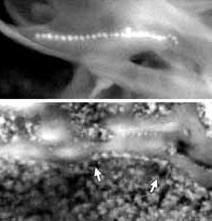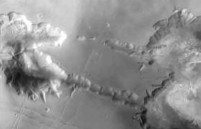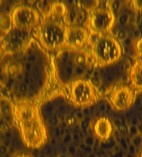Top: magnetite chain in terrestrial bacterium

Bottom: magnetite chain in ALH84001 |
February 27: The case for Martian bacteria grows stronger. Magnetites in a Mars meteorite are arranged in chains just like magnetites produced by bacteria on Earth. This congruence was not known in December, when a NASA team reported that the magnetites in ALH84001 meet all but one of the six criteria established by biological ones. Now the lacking criterion, the presence of chains, has been met as well.
 E. Imre Friedmann et al., "Chains of magnetite crystals in the meteorite ALH84001: Evidence of biological origin" [abstract], p 2176-2181 v 98 n 5, Proc. Natl. Acad. Sci. USA, 27 February 2001.
E. Imre Friedmann et al., "Chains of magnetite crystals in the meteorite ALH84001: Evidence of biological origin" [abstract], p 2176-2181 v 98 n 5, Proc. Natl. Acad. Sci. USA, 27 February 2001.
 Kathie L. Thomas-Keprta et al., "Truncated hexa-octahedral magnetite crystals in ALH84001: Presumptive biosignatures" [abstract, full text in PDF], p 2164-2169 v 98 n 5, Proc. Natl. Acad. Sci. USA, 27 February 2001.
Kathie L. Thomas-Keprta et al., "Truncated hexa-octahedral magnetite crystals in ALH84001: Presumptive biosignatures" [abstract, full text in PDF], p 2164-2169 v 98 n 5, Proc. Natl. Acad. Sci. USA, 27 February 2001.
 Scientists Find Evidence of Ancient Microbial Life on Mars, Kathleen Burton, NASA Newsrelease 01-14AR, 26 February 2001.
Scientists Find Evidence of Ancient Microbial Life on Mars, Kathleen Burton, NASA Newsrelease 01-14AR, 26 February 2001.
 Does The Famous Martian Meteorite Really Point To Life?, by Leonard David, Space.com, 28 March 2001.
Does The Famous Martian Meteorite Really Point To Life?, by Leonard David, Space.com, 28 March 2001.
 2000, December 13: Evidence for magnetotactic bacteria on Mars is a related What'sNEW item.
2000, December 13: Evidence for magnetotactic bacteria on Mars is a related What'sNEW item.
Also, evidence similar to that found in ALH84001 has been found in two other Mars meteorites, Nakhla and Shergotty, that are 1.3 billion and 165 to 175 million years old, respectively. The particles are embedded in clay, so the case that they could be earthly contaminants is not easily made.
 Four Years Later...[PDF], NASA Newsrelease re: E.K. Gibson et al. Precambrian Research v 106, 23 February 2001.
Four Years Later...[PDF], NASA Newsrelease re: E.K. Gibson et al. Precambrian Research v 106, 23 February 2001.
 Case for Life on Mars Withstands Criticism, Gains Scientific Support, Catherine E. Watson, NASA Newsrelease J01-20, 26 February 2001.
Case for Life on Mars Withstands Criticism, Gains Scientific Support, Catherine E. Watson, NASA Newsrelease J01-20, 26 February 2001.
 1999, March 19: Other meteorites may show life on Mars is a related What'sNEW item.
1999, March 19: Other meteorites may show life on Mars is a related What'sNEW item.
 Life on Mars! is the related CA webpage.
Life on Mars! is the related CA webpage.
February 26:
Non-biological chemistry cannot produce the organic molecules in comets. The process would be too slow to compete with the destructive effect of ultraviolet light, according to a new report from NASA's Ames Research Center. Biological production is not considered in the report. [Thanks, New Scientist, 17 February.]
 S. D. Rodgers and S. B. Charnley, "Organic synthesis in the coma of Comet Hale-Bopp?" p L61 v 320 n 4 Monthly Notices of the Royal Astronomical Society, 1 February 2001.
S. D. Rodgers and S. B. Charnley, "Organic synthesis in the coma of Comet Hale-Bopp?" p L61 v 320 n 4 Monthly Notices of the Royal Astronomical Society, 1 February 2001.
 Comets... is a related CA webpage.
Comets... is a related CA webpage.
February 23:
An asteroid impact may have caused a mass extinction 250 million years ago.
 Luann Becker et al. "Impact Event at the Permian-Triassic Boundary: Evidence from Extraterrestrial Noble Gases in Fullerenes" [abstract], p 1530-1533 v 291 Science, 23 Februrary 2001.
Luann Becker et al. "Impact Event at the Permian-Triassic Boundary: Evidence from Extraterrestrial Noble Gases in Fullerenes" [abstract], p 1530-1533 v 291 Science, 23 Februrary 2001.
 Apocalypse Then, Science@NASA, 23 February 2001.
Apocalypse Then, Science@NASA, 23 February 2001.
February 23:
Special astrobiology report, based on a series of six lectures in January and February, 2000, at Penn State University. [Thanks, Larry Klaes.]
 Looking for Life Beyond Earth, by David Pacchioli, Space.com, 22 February 2001.
Looking for Life Beyond Earth, by David Pacchioli, Space.com, 22 February 2001.
February 21:
Complex carbon molecules and water found in dust around distant stars — A panel of researchers presented data from the Submillimeter Wave Astronomy Satellite and the Infrared Space Observatory at the national meeting of the American Association for the Advancement of Science. Most scientists interpret the findings to mean that life might easily originate in such favorable pre-biotic conditions. We think that the complex organics might well be "post-biotic." [Thanks, Stan Franklin.]
 Associated Press, "Astronomers Find Life Ingredients" [text], The New York Times, 21 February 2001.
Associated Press, "Astronomers Find Life Ingredients" [text], The New York Times, 21 February 2001.
 Interstellar Dust is a related CA webpage.
Interstellar Dust is a related CA webpage.
 February 21:
February 21:
Earth-like planets appear commonplace. A new survey of nearby stars shows that more than half are rich in iron. Iron-bearing planets are likely to have formed around these stars.
 Planets like Earth are probably commonplace in the Universe..., New Scientist Online News, 20 February 2001.
Planets like Earth are probably commonplace in the Universe..., New Scientist Online News, 20 February 2001.
February 17:
Gene transfer in archaea — Biologists in Denmark and Germany have found that "site-specific integration of different genetic elements into archaeal chromosomes is a general phenomenon." They conclude that archaeal integrases may "facilitate gene transfer between archaea, bacteria and eukaryotes." Gene transfer mechanisms were already well-known among bacteria and eukaryotes; this new research shows that archaea can also participate in the exchange.
 Qunxin She et al. "Gene capture in archaeal chromosomes" p 478 v 409 Nature, 25 January 2001.
Qunxin She et al. "Gene capture in archaeal chromosomes" p 478 v 409 Nature, 25 January 2001.
 Viruses... is a related CA webpage. [Next-What'sNEW about HGT-Prev]
Viruses... is a related CA webpage. [Next-What'sNEW about HGT-Prev]
February 12:
The human genome has only about 30,000 genes, according to two groups that have nearly completed sequencing it. This number is 30% of the estimate of 100,000 given in many textbooks. For comparison, the lowly roundworm has 19,000 genes. While the length of the human genome, 3.2 billion nucleotide pairs, has not been revised, the proportion recognized as translatable genes [omitting introns] is now seen to be only about one-and-a-half percent. Another surprise is that neither group found any evidence that the human genome arose from two accidental doublings of the early animal genome, as was previously supposed.
The two groups are Celera Genomics of Rockville, Md., and the International Human Genome Sequencing Consortium, a group of academic centers financed largely by the National Institutes of Health and the Wellcome Trust of London. Fierce competition between them quickened the sequencing project by two or three years. Their reports will be published in the forthcoming issues of Science and Nature, respectively.
The consortium paper, with Dr. Eric Lander of the Whitehead Institute in Cambridge MA as lead author, observes that at least 113 genes, and possibly many more, have been transferred directly from bacteria and installed in the human genome.
Dr. J. Craig Venter, president of Celera and lead author of the paper in Science, says his team found only 300 human genes that had no counterpart in the mouse genome. To him, the task of sequencing and interpreting the human genome was "mentally exhausting, in part because we are not mentally equipped to absorb all this.... We feel like midgets describing the universe and we can't comprehend it all."
 Nicholas Wade, "Analysis of Human Genome Discovers Far Fewer Genes," The New York Times, 12 Februrary 2001.
Nicholas Wade, "Analysis of Human Genome Discovers Far Fewer Genes," The New York Times, 12 Februrary 2001.
 International Human Genome Sequencing Consortium, "Initial sequencing and analysis of the human genome" [abstract], p 860-921 v 409, Nature, 15 Februrary 2001.
International Human Genome Sequencing Consortium, "Initial sequencing and analysis of the human genome" [abstract], p 860-921 v 409, Nature, 15 Februrary 2001.
 J. Craig Venter et al. "The Sequence of the Human Genome" [abstract], p 1304-1351 v 291, Science, 16 Februrary 2001.
J. Craig Venter et al. "The Sequence of the Human Genome" [abstract], p 1304-1351 v 291, Science, 16 Februrary 2001.
 A journey into the genome: what's there, by Henry Gee, Nature Science Update, 12 February 2001. "The genome is a museum of the viral infections suffered by humanity and its ancestors. Viruses made us what we are."
A journey into the genome: what's there, by Henry Gee, Nature Science Update, 12 February 2001. "The genome is a museum of the viral infections suffered by humanity and its ancestors. Viruses made us what we are."
 Viruses... is a related CA webpage. [Next-What'sNEW about HGT-Prev]
Viruses... is a related CA webpage. [Next-What'sNEW about HGT-Prev]
 Can the Theory Be Tested? has a section on sequencing the human genome.
Can the Theory Be Tested? has a section on sequencing the human genome.
February 7:
More about the Viking biology experiments on Mars — The National Space Science Data Center is reorganizing the original data from the Viking Lander biology experiments to facilitate their reconsideration. And Gil Levin, who designed the Viking "Labeled Release" experiment, is lobbying for a chance, on an early upcoming Mars mission, to settle the question of microbial life on Mars.
 Viking Lander Biology Data Restored by NSSDC and PDS, by Joseph King, NSSDC News, September 2000.
Viking Lander Biology Data Restored by NSSDC and PDS, by Joseph King, NSSDC News, September 2000.
 Dana Hedgpeth, "The Man Who Wants a Return Ticket to Mars" [text], p A01, Washingon Post, 1 December 2000.
Dana Hedgpeth, "The Man Who Wants a Return Ticket to Mars" [text], p A01, Washingon Post, 1 December 2000.
February 2:
Biological interpretation of Viking LR experiment on Mars can no longer be ruled out. This is the punchline of an article by Warmflash et al. to be presented on March 15, at the Lunar and Planetary Society Conference in Houston, TX. And in a forthcoming article Glavin et al. demonstrate that the Viking GCMS experiment would fail to notice organics in Mars-like soil that contains several million bacterial cells per gram. [Thanks, Barry DiGregorio and Michael Paine.]
 D.M.
Warmflash, S.J. Clemett, and D.S. McKay, "Organic Matter in SNC Meteorites: Time to Re-evaluate the Viking Biology Experimental Data?" [PDF], 32nd Lunar and Planetary Science Conference, Houston TX, 12-16 March 2001.
D.M.
Warmflash, S.J. Clemett, and D.S. McKay, "Organic Matter in SNC Meteorites: Time to Re-evaluate the Viking Biology Experimental Data?" [PDF], 32nd Lunar and Planetary Science Conference, Houston TX, 12-16 March 2001.
 Daniel P. Glavin, Michael Schubert, Oliver Botta, Gerhard Kminek, Jeffrey L. Bada, "Detecting pyrolysis products from bacteria on Mars," v 185 n 1-2 Earth And Planetary Science Letters, 15 February 2001.
Daniel P. Glavin, Michael Schubert, Oliver Botta, Gerhard Kminek, Jeffrey L. Bada, "Detecting pyrolysis products from bacteria on Mars," v 185 n 1-2 Earth And Planetary Science Letters, 15 February 2001.
 Vikings would have missed life on Mars, by Philip Ball, Nature Science Update, 13 February 2001.
Vikings would have missed life on Mars, by Philip Ball, Nature Science Update, 13 February 2001.
 January 31:
January 31:
Where to land on Mars: Engineers favor flat terrain; researchers want variety.
 Turf Wars Over Mars Rover Landing Sites, by Leonard David, Space.com, 31 January 2001.
Turf Wars Over Mars Rover Landing Sites, by Leonard David, Space.com, 31 January 2001.
January 31:
National Geographic pictures Mars.
 Kathy Sawyer. "A Mars Never Dreamed Of," p 30-51 v 199 n 2 National Geographic, February 2001.
Kathy Sawyer. "A Mars Never Dreamed Of," p 30-51 v 199 n 2 National Geographic, February 2001.
 Life on Mars! is the related CA webpage.
Life on Mars! is the related CA webpage.
January 30:
Jupiter-like planets may be needed for life on smaller ones.
 Only Solar Systems with Jupiters May Harbor Life..., The University of Arizona, 29 January 2001
Only Solar Systems with Jupiters May Harbor Life..., The University of Arizona, 29 January 2001
 Without Jupiter, Home Alone, NASA's Astrobiology Institute, 01 February 2001
Without Jupiter, Home Alone, NASA's Astrobiology Institute, 01 February 2001
 Jonathan I. Lunine. "The occurrence of Jovian planets and the habitability of planetary systems" [abstract], p 809-814 v 98 n 3 Proc. Natl. Acad. Sci. USA, 30 January 2001.
Jonathan I. Lunine. "The occurrence of Jovian planets and the habitability of planetary systems" [abstract], p 809-814 v 98 n 3 Proc. Natl. Acad. Sci. USA, 30 January 2001.
 Life on Mars! is a related CA webpage.
Life on Mars! is a related CA webpage.
 January 29:
January 29:
"NASA Scientists Find Clues That Life Began in Deep Space." This is the headline of a NASA newsrelease about work by Jason Dworkin of the SETI Institute, Scott Sandford of NASA Ames, David Deamer of the Chemistry and Biochemistry Department of UC Santa Cruz, and Louis J. Allamandola of the SETI Institute. Their experiments "created solid materials which, when immersed in water, spontaneously created soap bubble-like membranous structures that contained both an 'inside' and an 'outside' layer." These solid materials were formed in an environment with properties resembling outer space. This work supports origin-of-life theories in the category that we describe as "containers first." NASA is promoting the research as a major breakthrough.
We are acquainted with three of these scientists and we respect them all. But we do not agree with NASA that this research brings us anywhere close to understanding the origin of life. As we have stressed, the origin of life problem has two aspects analogous to "hardware" and "software." This research introduces a new speculation into the hardware aspect of the problem. Meanwhile, science has all but given up on explaining the origin of the genetic instructions necessary for life, the software aspect of the problem.
Dworkin himself seems more restrained, saying "Membranes are like a house. Maybe these molecules were just the raw lumber lying around that allowed origin-of-life chemicals to move in and set up housekeeping or construct their own houses." He appears to realize that we don't even know if the origin of life from nonliving chemicals by natural means is possible. If NASA would recognize this fact, perhaps it would publicize its research without misleading the general public.
 Scientists find clues that the path leading to the origin of life begins in deep space, by Jason P. Dworkin, re: PNAS article of 30 January 2001
Scientists find clues that the path leading to the origin of life begins in deep space, by Jason P. Dworkin, re: PNAS article of 30 January 2001
 Scientists Find Clues That Life Began in Deep Space, NASA's Astrobiology Institute, 30 January 2001
Scientists Find Clues That Life Began in Deep Space, NASA's Astrobiology Institute, 30 January 2001
 Jason P. Dworkin et al. "Self-assembling amphiphilic molecules: Synthesis in simulated interstellar/precometary ices" [abstract], p 815-819 v 98 n 3 Proc. Natl. Acad. Sci. USA, 30 January 2001.
Jason P. Dworkin et al. "Self-assembling amphiphilic molecules: Synthesis in simulated interstellar/precometary ices" [abstract], p 815-819 v 98 n 3 Proc. Natl. Acad. Sci. USA, 30 January 2001.
 The New York Times chose not to report this story.
The New York Times chose not to report this story.
 The RNA World is a related CA webpage.
The RNA World is a related CA webpage.
 January 29:
January 29:
NASA discusses "terraforming" Mars with bacteria.
 Greening of the Red Planet, Science@NASA, 26 January 2001
Greening of the Red Planet, Science@NASA, 26 January 2001
 Global Warming on Mars, Science@NASA, 9 February 2001
Global Warming on Mars, Science@NASA, 9 February 2001
 Gaia is a related CA webpage.
Gaia is a related CA webpage.
January 23:
Japanese scientists have found 3,554 meteorites in Antarctica. The finds were made during a three-week search around the Yamato mountain range about 185 miles (300 kilometers) from Japan's base on the rim of Antarctica, between 19 November and 10 January.
 Japanese Team Finds 3,554 Meteorites, Associated Press, Lubbock Avalanche-Journal, 24 January 2001
Japanese Team Finds 3,554 Meteorites, Associated Press, Lubbock Avalanche-Journal, 24 January 2001
 Comets... is a related CA webpage.
Comets... is a related CA webpage.
 January 17:
January 17:
Earth had liquid water 4.3 to 4.4 billion years ago, roughly half a billion years earlier than previously thought. The conclusion is based on two different science teams' analyses of isotope ratios in ancient zircon crystals.
 Simon A. Wilde et al., "Evidence from detrital zircons for the existence of continental crust and oceans on the Earth 4.4 Gyr ago," p 175-178 v 409 Nature, 11 January 2001.
Simon A. Wilde et al., "Evidence from detrital zircons for the existence of continental crust and oceans on the Earth 4.4 Gyr ago," p 175-178 v 409 Nature, 11 January 2001.
 Stephen J. Mojzsis et al., "Oxygen-isotope evidence from ancient zircons for liquid water at the Earth's surface 4,300 Myr ago," p 178-181 v 409 Nature, 11 January 2001.
Stephen J. Mojzsis et al., "Oxygen-isotope evidence from ancient zircons for liquid water at the Earth's surface 4,300 Myr ago," p 178-181 v 409 Nature, 11 January 2001.
 Precocious Earth, from NASA's Astrobiology Institute, 17 January 2001.
Precocious Earth, from NASA's Astrobiology Institute, 17 January 2001.
 Life Before 3850 Million Years Ago? is a related CA webpage.
Life Before 3850 Million Years Ago? is a related CA webpage.
